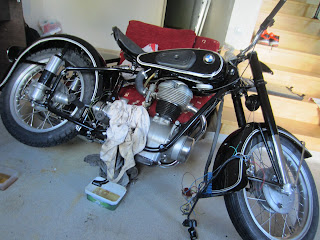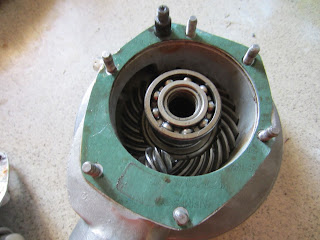It's been literally years since my last update here. Not that I lost interest or something, on the contrary, simply because I could hardly spend merely a handful of net days on the work in the meantime. And this is going to be a bland overview of those days, without any significant entertainment.
Last time when I left the Beemer, I had successfully stopped the oil leaks (to a great extent, I should say) and tidied up the cabling and connections. Now is the time for the grand opening! Well, that was two years ago, actually. Ready for the engine start!
So, did it? Of course not, how come can you think that I'm that lucky at all! During "both" those years, I've been investigating and researching about my mistake, where it could lie, what I could have done wrong. Finally I have the answer - so elementary!
Let's review the potential failure elements. After all, there are only three basic variables that make a combustion engine run: if there was something wrong with the caburetor (fuel feed) it would have been obvious to the visual inspection. It could have been something with the electrics (spark timing) but I learned a lot about it and I'm fairly fit dealing with it.
There remains only the cam timing, which makes sure the air-fuel mix gets into the cylinder and exhaust gas after the ignition gets out of the cylinder at the right time - that is, when the piston is at the right position. The cam timing is not something you're supposed to adjust; it is one of the key parameters specified during the engine design. In straightforward terms, the crankshaft, where the piston is attached to (the large shaft and its sprocked below the ball bearing in the photo) and the camshaft (larger sprocket) have only one correct position relative to eachother. The camchain in between maintains this relative position, provided that you pay extreme attention, take multiple measurements and set it correctly when fitting it. Or else!!!
Running out of ideas, I decided to check the cam timing one last time. Opened the valve cover on top of the engine head, watching the "Top Dead Center" mark which is conveniently visible on the flywheel through a small hole on the block, started carefully rotating the crankshaft by hand and waiting for the valves to move. The time is measured in crankshaft angles, and it is well specified which valve opens at what degrees.
Well, here comes the disaster! The valves are almost 45 degrees too advanced! The crankshaft sprocket has sixteen teeth, therefore we have 360/16=22.5 degrees per tooth. This means I am off, not by one tooth but two! How careless, how stupid, how come I didn't notice that at all!
There remains only the cam timing, which makes sure the air-fuel mix gets into the cylinder and exhaust gas after the ignition gets out of the cylinder at the right time - that is, when the piston is at the right position. The cam timing is not something you're supposed to adjust; it is one of the key parameters specified during the engine design. In straightforward terms, the crankshaft, where the piston is attached to (the large shaft and its sprocked below the ball bearing in the photo) and the camshaft (larger sprocket) have only one correct position relative to eachother. The camchain in between maintains this relative position, provided that you pay extreme attention, take multiple measurements and set it correctly when fitting it. Or else!!!
Running out of ideas, I decided to check the cam timing one last time. Opened the valve cover on top of the engine head, watching the "Top Dead Center" mark which is conveniently visible on the flywheel through a small hole on the block, started carefully rotating the crankshaft by hand and waiting for the valves to move. The time is measured in crankshaft angles, and it is well specified which valve opens at what degrees.
Well, here comes the disaster! The valves are almost 45 degrees too advanced! The crankshaft sprocket has sixteen teeth, therefore we have 360/16=22.5 degrees per tooth. This means I am off, not by one tooth but two! How careless, how stupid, how come I didn't notice that at all!
So I removed the engine block, opened the front cover, removed the cam chain and reattached at the right position. After several measurements to make sure I got it right this time, buttoned the engine up again and brought the poor old Beemer back together. These two sentences took me about one full day.
I've got a new and fully charged battery. Revisited the ignition timing, that looks good, too. I even found a couple liter of gas in a jerry can lying at the corner - definitely a year old or two, stale and smells a bit foul, not ideal but should pull off anyway. The cylinder walls must be bone dry, I dripped a few cl's of engine oil through the spark plug hole, to help reduce the friction and improve the isolation of the chamber by sticking between the piston rings. Turned the ignition on, twisted the throttle a little, started kicking. After a few kicks, coughs and sputters, came a huge puff of blue smoke (that's the rest of the oil I dripped burning away) and it STARTED!!!
Started but shaking like an old washing machine. No wonder, that is due to my negligence, too. While I took the engine apart, I renewed the cracked connection rod and the bearings on the crankshaft, and just roughly had it pressed again and convinced by just an eyeball estimate. If you are talking about a cast iron mass of few kilos, rotating several thousand times every minute, that is definitely not the way to go. You should instead make absolutely sure that the rotating axle is properly balanced within the specified tolerance, which is, according to the official documentation, two hundredths of a millimeter! About thickness of a hair, for a real world example. Anyway, the way ahead is much clearer now, at least I know what it takes to reach this point.
Well then, what now? Hadn't I moved abroad, I would have long since bought a few important tools I was considering for a while and had a proper amateur workshop. But under current circumstances, there is no light yet in the tunnel. It is not realistic to keep working and expect anything reasonable at the rate of roughly a few days per year. I do hope that I will some day eventually bring together the little workshop here, and the first thing I'll do then would be to transport the little Beemer over here. Unfortunately it is way too early for that.
All I can do now, is to give my apologies to my Old Beemer and put an end to our journey. Looking back, beside all the new-to-me technical skills and knowledge, I have learned many lessons and dusted off a lot of information and wisdom about engineering discipline and about life in general. That is all I have earned anyway, otherwise it's been an endless money pit - worth every penny.
I'm already looking forward to carrying on with the work!





















































